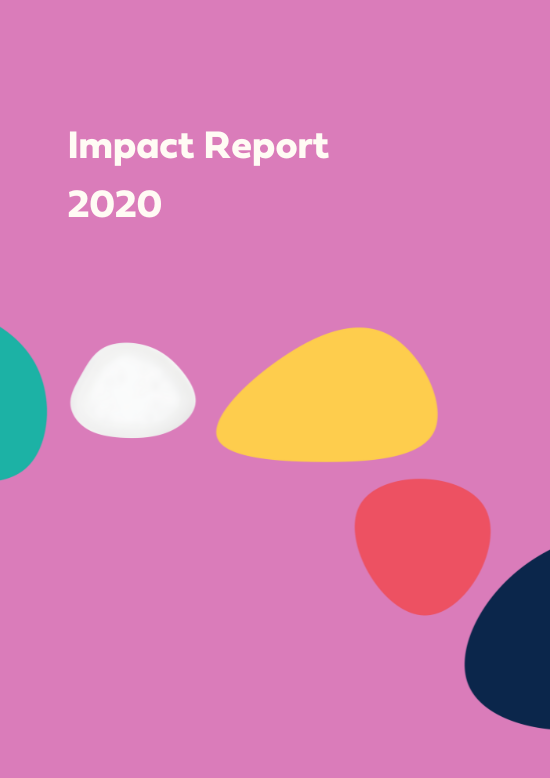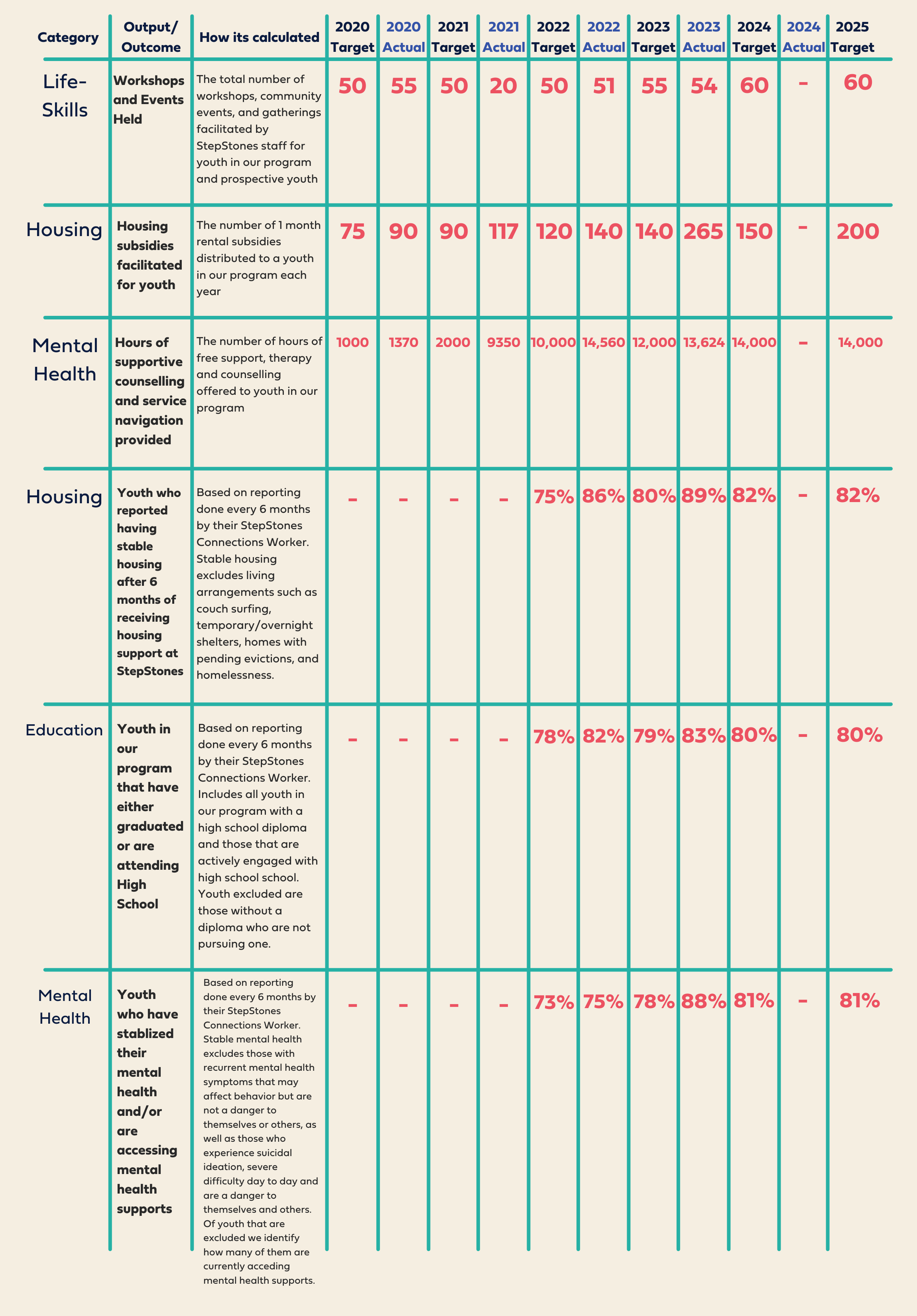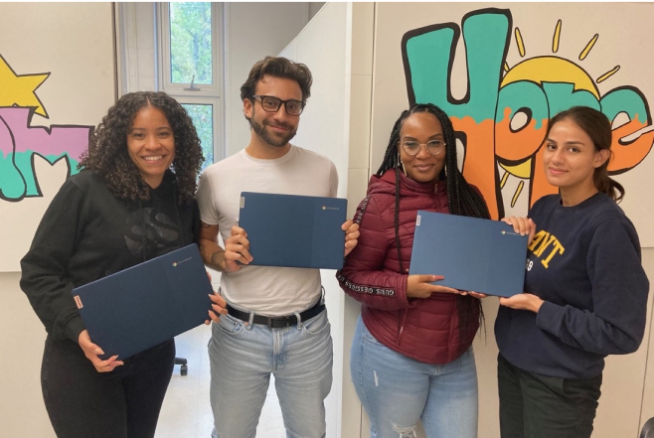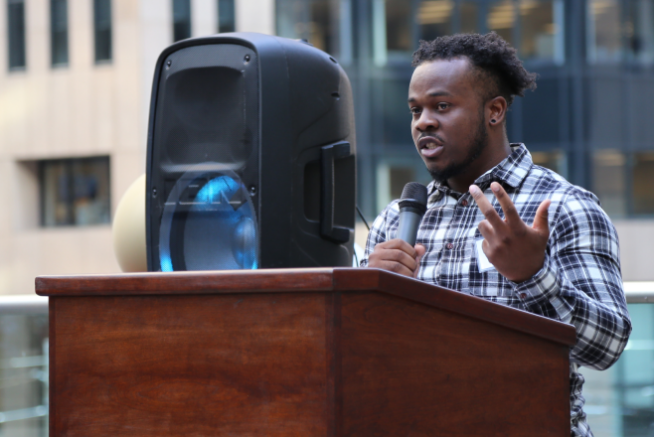At StepStones, we set our goals high. In our perfect world, all youth graduate high school, are pursuing further education or have found meaningful employment, have safe and secure housing, and live with a sense of belonging and positive mental health.
However, statistics across jurisdictions show that youth from foster care who are transitioning to adulthood face far greater challenges and experience poorer life outcomes compared to their peers who were not in care. These outcomes include lower educational attainment, difficulty obtaining employment, ongoing housing instability, isolation, and involvement in the criminal justice system.
While StepStones’ programming helps mitigate the negative consequences of involvement in foster care and transitioning out of the system, there are outcomes that can be improved as we work towards individual successes and systemic changes. Based on data from our intake interviews with each young person and subsequent data collected every six months during their involvement with us, we are able to track their progress and use data trends to inform and improve our programming.
Here are four examples of changes we have made to our programs and policies in recent years based on our learnings from data collection and evaluation:
The Importance of Connection
With the backing and belief of our supporters, StepStones for Youth continues to achieve impressive outcomes for vulnerable young people in and from foster care. With 58% of homeless youth in any given year reporting involvement in child welfare, 89% of youth attain stable housing after 6 months in our program. While only 48% of youth from foster care graduate high school, 83% of youth in our program are currently attending or have graduated. as low as 7% of youth at intake to our program report stable mental health. After one year with StepStones, this statistic sharply increases to 88%. Our key learnings highlight that young people from foster care can have all the education, housing, and mental health support they need but without long-term, kinship connections with caring, non-paid adults, their trajectories continue downwards. Our outcomes tell us that our upstream approach anchored in relational connections work helps vulnerable young people overcome barriers to reaching their potential.
Numbers of Connections for Youth
Our original concept for our work to find permanency for youth was based on research and models that had been showing some evidence of success. One such model, demonstrated that they were able to identify over 100 relatives or connections within 30 days at the time of a child’s apprehension. We learned that this metric doesn’t apply for older youth who have been living in foster care for longer periods of time. We found youth in our program to be apprehensive about connecting with members of their extended family due to the traumas that resulted in their apprehension, as well as the trauma of apprehension and their experience of instability in the foster care system. We also realized that the metric of finding 100 connections for each young person was creating barriers to positive connections that are found quickly. In several instances, individuals would agree to become primary caregivers while we would still be in the stages of seeking further individuals to reach our intended metric, thus stalling the progress of the secured connections. We now understand further that the permanency work must continue even after young people have been matched with primary caregivers so that they can continue to build circles of support in their lives. To improve the outcomes for young people in our program regarding connection and permanency, we reduced the intended number of connections to 50, as well as the number of individuals in each youth’s circle of support from 8 to 5, to excellent results.
When we launched a new pilot project at the start of the COVID-19 pandemic in 2020 in response to the dire circumstances of shelters at capacity and youth experiencing isolation and mental health crises, we entitled it Safe at Home. Our project incorporated evidence-backed findings that young people involved in the child welfare system require not only long-term housing but also strong, natural connections with non-paid individuals to make healthy and secure transitions out of foster care and into young adulthood. This knowledge applies across all areas of our intended outcomes for young people including housing, education and employment, mental and physical health, and cultural and community associations. The new name for our over-arching program, Building Connections, is the result of this learning and the sharpening of our vision.
In 2023, StepStones lost a dear friend and colleague, Shuah Roskies. Before her sudden passing, Shuah further honed the heart of the issue as StepStones’ Director of Innovation, Awareness, and Education. Children and youth in and from foster care are most often disconnected from their cultural backgrounds and require upstream approaches for reconnecting with, reclaiming, and strengthening their identities. Beyond employment programs and housing grants, we have learned that young people involved in child welfare need long-term, relational connections with non-paid adults to increase their sense of belonging, reconnect with their origins, and develop trust. The gap in service for young people involved in child welfare that StepStones addresses is reducing isolation, disconnection, and social exclusion by utilizing human resources that already exist, such as extended family and pre-existing relationships with community members but require sensitive and skillful approaches to mobilize.
Expanding our Reach
To help youth attain and maintain appropriate housing that meets their needs, including youth with infants and youth who require housing in proximity to their schools or jobs, StepStones provides supports through a large geographical catchment beyond the GTA including Durham and Peel regions. While most young people who enter foster care are from low-income and priority neighbourhoods, the foster homes they are placed in are often located in middle-or upper-class areas. During the young person’s time in these placements, the community services and cultural community hubs they require are not accessible to them. With this knowledge, StepStones is taking a pro-active approach to reducing barriers to services by connecting with youth-serving and cultural organizations and agencies across different socio-economic neighbourhoods to ensure youth can access required supports across these jurisdictions wherever they may be.
Group vs Individual Work
In working with young people, our original intention was to build comradery and increase a sense of trust by engaging youth in group retreats in the initial stages of their time at StepStones. We found, over time, that youth were less open to sharing their histories and experiences in a group setting as they were with a one-to-one Connection Coordinator. We found that doing mobility mapping in groups is not as effective as doing it individually as it brings up personal stories, experiences of trauma, and information that youth do not feel comfortable exposing in group settings. We have found that a one-to-one Connection Coordinator, working with a young person to go through their histories, builds trust in this process, allows youth to examine their life and needs in a supportive environment, and produces better results for building connections and finding long-term success.









